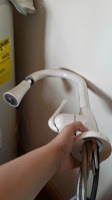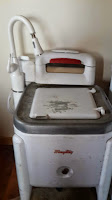Now that I am grown I hang out my own feeders and I enjoy building my own. If you enjoy hummingbirds and enjoy making your own feeders, I hope you will enjoy this and find it helpful. I have a couple different designs that I have built but I will start with a popular design right now that uses bottles from wine, sparkling juice, soda and even mason canning jars with a feeder tube (or two, or three or four) attached. There are many places that sell pre-made feeder tubes but I made my own using things I had on hand and it was simple and of course much cheaper. I am going to try and link this blog to a site online where you can also purchase these great recycled feeders if you choose.
 1st I drank a bottle of sparkling juice with my kids and husband over a pot roast dinner and saved the bottle. This particular variety of sparkling juice had a twist on and off cap so I decided to use that to my advantage (but I will also show ways to make feeder tubes that will work with bottles that do not have resealable caps). 2nd
I looked around the house and found some extra, flexible, plastic
tubing lying around. (Truth be told it was some old oxygen tubing that
my son required when he was born. Thank heaven he no longer needs it
for its original purpose, but he does love watching birds outside so I
thought re-purposing the tubing for a bird feeder was perfect!) If you
have some flexible copper tubing or anything similar it will work fine
too. I cut the tubing into about 6" sections and then dug through my
drill bits looking for a bit that was the same diameter as my tubing-or
at least fairly close.
1st I drank a bottle of sparkling juice with my kids and husband over a pot roast dinner and saved the bottle. This particular variety of sparkling juice had a twist on and off cap so I decided to use that to my advantage (but I will also show ways to make feeder tubes that will work with bottles that do not have resealable caps). 2nd
I looked around the house and found some extra, flexible, plastic
tubing lying around. (Truth be told it was some old oxygen tubing that
my son required when he was born. Thank heaven he no longer needs it
for its original purpose, but he does love watching birds outside so I
thought re-purposing the tubing for a bird feeder was perfect!) If you
have some flexible copper tubing or anything similar it will work fine
too. I cut the tubing into about 6" sections and then dug through my
drill bits looking for a bit that was the same diameter as my tubing-or
at least fairly close.3rd Once I found the drill bit I attached it to my power drill and bored a hole through the center of the screw-on cap and inserted the tubing through it. I've heard some people say the tube should be about 2" inside the bottle and 4" out, but I only put the tube in about an 1" or so inside the bottle.

4th Even though the tube fit snugly into the drilled hole of the cap, I fired up the hot glue gun and put a bead around the tube both on the inside and outside of the cap to seal it up. (For non-resealable caps, I simply used a cheap cork, drilled through it, just as I did the twist-off cap, inserted the tube inside with about an 1" inside the bottle and about 4" outside, then sealed it up with hot glue exactly as i did with the cap. Keep a steady hand when drilling the cork as it is soft! )
5th I didn't want bees or other insects crawling up into the tube and I wanted the opening of the tube to be small enough to prevent excess leaking. After some thought, I used some colored electrical tape (hummingbirds are supposed to be drawn to the colors red and yellow) and covered the end of the tube with a small piece,
then secured that piece by wrapping a little electrical tape around the outside of the end of the tube. With the end of the feeder tube successfully sealed off, I poked a small hole through the tape on the end of the tube with a paperclip and wiggled it around so that it was about the right size for a little hummingbird beak to fit.
 6th I needed a hanger! I had some twine around which would work fine, but i decided to use some stiff wire we had out back that is so miserable to bend that no one ever uses it to fix fences or wire up anything. I like being able to put things to good use and it seemed stiff enough to do the job well. It took a while, using pliers, the bottle and my tabletop to start a nice, curving, spiraling wrap that was small enough on one end to carefully cradle the bottleneck and gradually large enough on the other end to hold the rest of the bottle securely and still have enough left over for a nice hanger. (I used about 30" or so for my large sparkling juice bottle.)
6th I needed a hanger! I had some twine around which would work fine, but i decided to use some stiff wire we had out back that is so miserable to bend that no one ever uses it to fix fences or wire up anything. I like being able to put things to good use and it seemed stiff enough to do the job well. It took a while, using pliers, the bottle and my tabletop to start a nice, curving, spiraling wrap that was small enough on one end to carefully cradle the bottleneck and gradually large enough on the other end to hold the rest of the bottle securely and still have enough left over for a nice hanger. (I used about 30" or so for my large sparkling juice bottle.)7th I decided to spray paint the old gray wire that i fashioned into a hanger to dress it up a bit. I had a copper color that would match the cap so i used it and loved it-but this is obviously not a necessary step. Lastly I wiggled the bottle into its new hanger and project done! All ready to be filled with nectar, hung up in a nice spot and enjoyed! (One tip about filling the bottle, try to fill it as full as possible and let all the air bubbles rise to the top before securing a cap or slowly twisting a cork with feeder tubes attached. This prevents any excess leaking although with the tiny holes on the ends of these tubes, I haven't had many problems with that! Please do remember though that in high wind areas, all feeders will leak.)
 |
| Any bottle with a tight sealing, screw on cap (or cork) can be converted easily, like this mason jar. The same process is used: drill through, insert tubes, add a hot glue seal, tape the ends, poke tiny holes in the tape on the ends and make your hanger. I found that in areas where the hummingbirds are not familiar with the single-tube feeders, I had more success adding a colorful plastic flower made of colored electrical tape to the end. To reduce any excess leaking, I found it was also helpful to wrap small lengths of pliable, left over copper electrical wires around the tubing to point the ends up. (NOTE: To avoid any leaking or excess dripping with your feeders, fill them up absolutely as full as you can and let all air bubbles rise to the top. Slowly screw on the tops or twist in the cork. Improper filling can make your feeder drain out in a day or less.) If you would rather purchase these great recycled creations today and make them another day, I am attempting to create a link here. |



























 8th I secured the pipe to the antique washer using 2 very large and very cheap plumbing pipe clamps.
8th I secured the pipe to the antique washer using 2 very large and very cheap plumbing pipe clamps.
